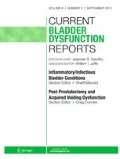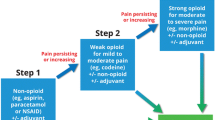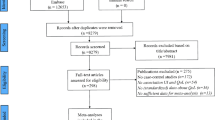Abstract
Overactive bladder (OAB) is a highly prevalent symptom condition that affects millions of US men and women. Not only can the symptoms of OAB be very bothersome, but OAB can have significant detrimental effects on many aspects of individuals’ lives, representing a particularly impactful health burden to quality of life and productivity. Estimates of the individual and societal costs for the management of OAB continue to rise, particularly as effective treatments remain elusive. As such, OAB represents a significant public health burden to the USA.
Similar content being viewed by others
References
Papers of particular interest, published recently, have been highlighted as: •• Of major importance
Abrams P, Cardozo L, Fall M, Griffiths D, Rosier P, Ulmsten U, et al. The standardisation of terminology of lower urinary tract function: report from the Standardisation Sub-committee of the International Continence Society. Neurourol Urodyn. 2002;21(2):167–78.
Stewart WF, Van Rooyen JB, Cundiff GW, Abrams P, Herzog AR, Corey R, et al. Prevalence and burden of overactive bladder in the United States. World J Urol. 2003;20(6):327–36. doi:10.1007/s00345-002-0301-4.
Coyne KS, Sexton CC, Vats V, Thompson C, Kopp ZS, Milsom I. National community prevalence of overactive bladder in the United States stratified by sex and age. Urology. 2011;77(5):1081–7. doi:10.1016/j.urology.2010.08.039.
Milsom I, Kaplan SA, Coyne KS, Sexton CC, Kopp ZS. Effect of bothersome overactive bladder symptoms on health-related quality of life, anxiety, depression, and treatment seeking in the United States: results from EpiLUTS. Urology. 2012;80(1):90–6. doi:10.1016/j.urology.2012.04.004.
Coyne KS, Sexton CC, Bell JA, Thompson CL, Dmochowski R, Bavendam T, et al. The prevalence of lower urinary tract symptoms (LUTS) and overactive bladder (OAB) by racial/ethnic group and age: results from OAB-POLL. Neurourol Urodyn. 2013;32(3):230–7. doi:10.1002/nau.22295. The OAB-POLL study is one of the most recent population-based studies to specifically examine the impact of OAB on work productivity and physical activity.
CDC. National Health and Nutrition Examination Study. http://www.cdc.gov/nchs/nhanes.htm. 2015.
Dooley Y, Kenton K, Cao G, Luke A, Durazo-Arvizu R, Kramer H, et al. Urinary incontinence prevalence: results from the National Health and Nutrition Examination Survey. J Urol. 2008;179(2):656–61. doi:10.1016/j.juro.2007.09.081.
Hartmann K, McPheeters M, Biller D, Ward R, McKoy J, Jerome R, et al. Treatment of overactive bladder in women. Evidence report/technology assessment No. 187. Rockville, MD: Agency for Healthcare Research and Quality; 2009.
Coyne KS, Margolis MK, Kopp ZS, Kaplan SA. Racial differences in the prevalence of overactive bladder in the United States from the epidemiology of LUTS (EpiLUTS) study. Urology. 2012;79(1):95–101. doi:10.1016/j.urology.2011.09.010.
Coyne KS, Wein A, Nicholson S, Kvasz M, Chen CI, Milsom I. Comorbidities and personal burden of urgency urinary incontinence: a systematic review. Int J Clin Pract. 2013;67(10):1015–33. doi:10.1111/ijcp.12164.
Dmochowski RR, Newman DK. Impact of overactive bladder on women in the United States: results of a national survey. Curr Med Res Opin. 2007;23(1):65–76. doi:10.1185/030079907X159533.
Kinsey D, Pretorius S, Glover L, Alexander T. The psychological impact of overactive bladder: a systematic review. J Health Psychol. 2014. doi:10.1177/1359105314522084.
Vrijens D, Drossaerts J, van Koeveringe G, Van Kerrebroeck P, van Os J, Leue C. Affective symptoms and the overactive bladder—a systematic review. J Psychosom Res. 2015;78(2):95–108. doi:10.1016/j.jpsychores.2014.11.019.
Coyne KS, Sexton CC, Clemens JQ, Thompson CL, Chen CI, Bavendam T, et al. The impact of OAB on physical activity in the United States: results from OAB-POLL. Urology. 2013;82(4):799–806. doi:10.1016/j.urology.2013.05.035.
Coyne KS, Sexton CC, Thompson CL, Clemens JQ, Chen CI, Bavendam T, et al. Impact of overactive bladder on work productivity. Urology. 2012;80(1):97–103. doi:10.1016/j.urology.2012.03.039.
Tang DH, Colayco DC, Khalaf KM, Piercy J, Patel V, Globe D, et al. Impact of urinary incontinence on healthcare resource utilization, health-related quality of life and productivity in patients with overactive bladder. BJU Int. 2014;113(3):484–91. doi:10.1111/bju.12505.
Wu EQ, Birnbaum H, Marynchenko M, Mareva M, Williamson T, Mallett D. Employees with overactive bladder: work loss burden. J Occup Environ Med / Am Coll Occup Environ Med. 2005;47(5):439–46.
McKinlay JB, Link CL. Measuring the urologic iceberg: design and implementation of the Boston Area Community Health (BACH) Survey. Eur Urol. 2007;52(2):389–96. doi:10.1016/j.eururo.2007.03.013.
Irwin DE, Milsom I, Kopp Z, Abrams P. Symptom bother and health care-seeking behavior among individuals with overactive bladder. Eur Urol. 2008;53(5):1029–37. doi:10.1016/j.eururo.2008.01.027.
Reynolds WS, McPheeters M, Blume J, Surawicz T, Worley K, Wang L, et al. Comparative effectiveness of anticholinergic therapy for overactive bladder in women: a systematic review and meta-analysis. Obstet Gynecol. 2015;125(6):1423–32. doi:10.1097/AOG.0000000000000851.
Shamliyan T, Wyman JF, Ramakrishnan R, Sainfort F, Kane RL. Benefits and harms of pharmacologic treatment for urinary incontinence in women: a systematic review. Ann Intern Med. 2012;156(12):861–74. doi:10.7326/0003-4819-156-12-201206190-00436. W301-10.
Chancellor MB, Migliaccio-Walle K, Bramley TJ, Chaudhari SL, Corbell C, Globe D. Long-term patterns of use and treatment failure with anticholinergic agents for overactive bladder. Clin Ther. 2013;35(11):1744–51. doi:10.1016/j.clinthera.2013.08.017.
Sexton CC, Notte SM, Maroulis C, Dmochowski RR, Cardozo L, Subramanian D, et al. Persistence and adherence in the treatment of overactive bladder syndrome with anticholinergic therapy: a systematic review of the literature. Int J Clin Pract. 2011;65(5):567–85. doi:10.1111/j.1742-1241.2010.02626.x.
Hall SA, Link CL, Hu JC, Eggers PW, McKinlay JB. Drug treatment of urological symptoms: estimating the magnitude of unmet need in a community-based sample. BJU Int. 2009;104(11):1680–8. doi:10.1111/j.1464-410X.2009.08686.x.
Maserejian NN, Minassian VA, Chen S, Hall SA, McKinlay JB, Tennstedt SL. Treatment status and risk factors for incidence and persistence of urinary incontinence in women. Int Urogynecol J. 2014;25(6):775–82. doi:10.1007/s00192-013-2288-3.
Benner JS, Nichol MB, Rovner ES, Jumadilova Z, Alvir J, Hussein M, et al. Patient-reported reasons for discontinuing overactive bladder medication. BJU Int. 2010;105(9):1276–82. doi:10.1111/j.1464-410X.2009.09036.x.
Gormley EA, Lightner DJ, Burgio KL, Chai TC, Clemens JQ, Culkin DJ, et al. Diagnosis and treatment of overactive bladder (non-neurogenic) in adults: AUA/SUFU guideline. J Urol. 2012;188(6 Suppl):2455–63. doi:10.1016/j.juro.2012.09.079.
Gormley EA, Lightner DJ, Faraday M, Vasavada SP, American Urological A. Society of Urodynamics FPM. Diagnosis and treatment of overactive bladder (non-neurogenic) in adults: AUA/SUFU guideline amendment. J Urol. 2015;193(5):1572–80. doi:10.1016/j.juro.2015.01.087. The AUA/SUFU Guidelines provide the most up-to-date, evidence-based guidelines for the diagnosis and treatment of OAB.
Ju R, Garrett J, Wu JM. Anticholinergic medication use for female overactive bladder in the ambulatory setting in the United States. Int Urogynecol J. 2013. doi:10.1007/s00192-013-2246-0.
Subak L, Van Den Eeden S, Thom D, Creasman JM, Brown JS. Reproductive Risks for Incontinence Study at Kaiser Research G. Urinary incontinence in women: direct costs of routine care. Am J Obstet Gynecol. 2007;197(6):596. doi:10.1016/j.ajog.2007.04.029. e1-9.
Subak LL, Brown JS, Kraus SR, Brubaker L, Lin F, Richter HE, et al. The “costs” of qurinary incontinence for women. Obstet Gynecol. 2006;107(4):908–16. doi:10.1097/01.AOG.0000206213.48334.09.
Ganz ML, Smalarz AM, Krupski TL, Anger JT, Hu JC, Wittrup-Jensen KU, et al. Economic costs of overactive bladder in the United States. Urology. 2010;75(3):526–32. doi:10.1016/j.urology.2009.06.096. The authors use prevalence-based models and a variety of current published sources to calculate the most comprehensive estimate for the total US societal costs for OAB.
Onukwugha E, Zuckerman IH, McNally D, Coyne KS, Vats V, Mullins CD. The total economic burden of overactive bladder in the United States: a disease-specific approach. Am J Manag Care. 2009;15(4 Suppl):S90–7.
Hu TW, Wagner TH, Bentkover JD, Leblanc K, Zhou SZ, Hunt T. Costs of urinary incontinence and overactive bladder in the United States: a comparative study. Urology. 2004;63(3):461–5. doi:10.1016/j.urology.2003.10.037.
Hu TW, Wagner TH, Bentkover JD, LeBlanc K, Piancentini A, Stewart WF, et al. Estimated economic costs of overactive bladder in the United States. Urology. 2003;61(6):1123–8.
Author information
Authors and Affiliations
Corresponding author
Ethics declarations
Conflict of Interest
Dr. Reynolds and Dr. Fowke declare that they have no conflict of interest. Dr. Dmochowski reports personal fees from Allergan and personal fees from Medtronic, outside the submitted work.
Human and Animal Rights and Informed Consent
This article does not contain any studies with human or animal subjects performed by any of the authors.
Additional information
This article is part of the Topical Collection on Overactive Bladder
Rights and permissions
About this article
Cite this article
Reynolds, W.S., Fowke, J. & Dmochowski, R. The Burden of Overactive Bladder on US Public Health. Curr Bladder Dysfunct Rep 11, 8–13 (2016). https://doi.org/10.1007/s11884-016-0344-9
Published:
Issue Date:
DOI: https://doi.org/10.1007/s11884-016-0344-9




